Psychonauts 2 Is Finally Happening If Backers Chip In On Fig
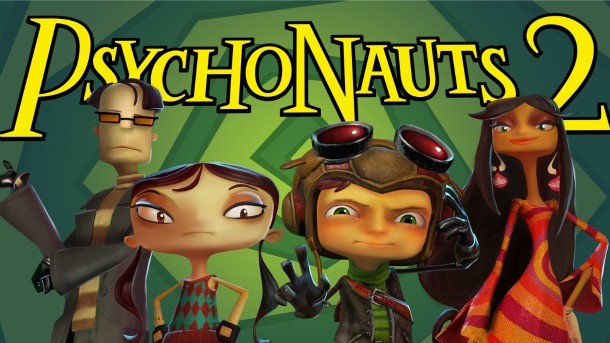
At the Game Awards 2015, Double Fine President Tim Schafer took the stage to unveil the Fig campaign for the long-requested Psychonauts 2. A sequel to the 2005 cult hit is something fans have longed for since its release, and thanks to Fig, they now have the opportunity to not only fund the game into existence, but to become actual project investors. It’s been a long time coming, and we caught up with Schafer to discuss the game’s direction, development history, and crowdfunding lessons.
Psychonauts 2 picks up after the first game’s cliffhanger ending. Raz and the gang arrive at Psychonauts headquarters following the rescue of Truman Zanotto, the Grand Head of the Psychonauts, who’d been kidnapped during the first game’s conclusion. One of the most exciting prospects of the sequel is getting the chance to work within the brain trust of the psychic agents.
“Where the first game was set in a summer camp where you're training to be a Psychonaut, now you are a Psychonaut and you're back at Psychonaut's headquarters seeing how they do it downtown – where they actually go on international espionage missions and exciting things like that,” Schafer says.
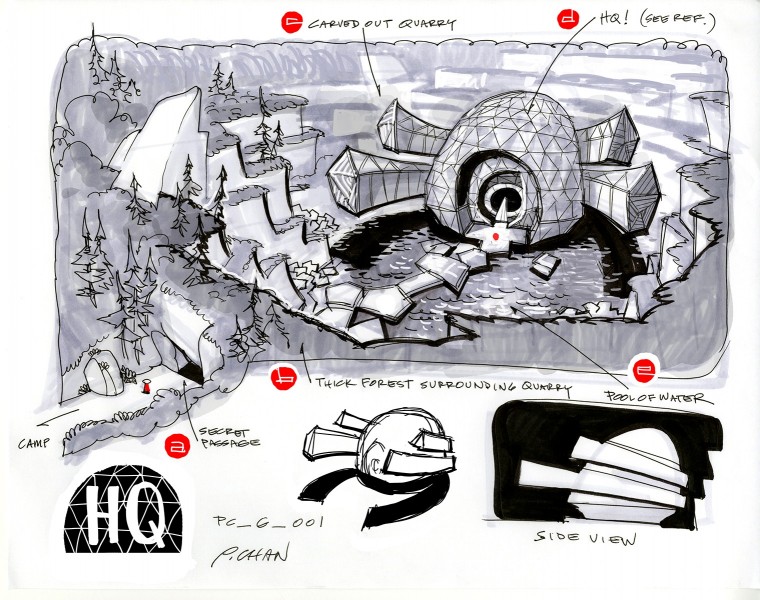
However, Raz soon discovers his organization is rife with internal problems and hidden, perhaps even sinister, agendas, leaving it up to him to uncover the truth and keep the Psychonauts alive. He’ll have some help from old allies, including his equally talented girlfriend, Lili Zanotto, as well as his camp counselors turned agency comrades Milla Vodello and Sasha Nein.
With the Psychonauts 2, Double Fine hopes to deliver a sequel that lives up to the original while also addressing the previous title’s weaknesses. “At a base level, we're trying to do all things people liked about the first game – just better," Schafer says. "We definitely want to refine and polish the movement of Raz, but also add a few new psychic powers.”
So far, Psychonauts 2 seems to be on the right track in terms of giving fans the things they liked before. Like the original, a central hub area acts as an exploratory junction point between the myriad of new minds that players will dive into. Another welcome return is that of Erik Wolpaw, who co-wrote the first Psychonauts and is once again lending a hand in penning the sequel.
Psychonauts’ main highlight was the collection of eccentric, demented minds that hosted a variety of unique and varied gameplay ideas. Visiting the mind of Linda the mutated Lungfish transformed Raz into a Godzilla-sized behemoth who smashed his way across a metropolitan area. Conversely, entering Fred Bonaparte’s psyche shrank players to the size of pawns used in a massive strategy board game against Fred’s ancestor, Napoleon. Players never knew what to expect from each world, which Schafer promises to deliver more of in the second game.
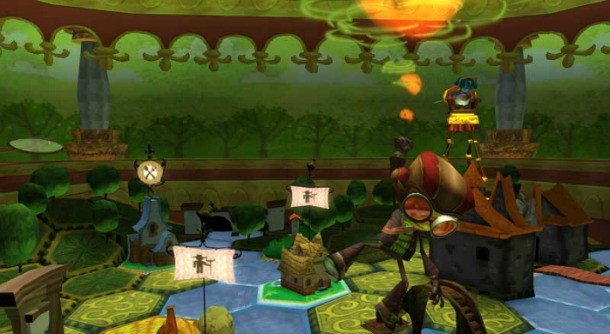
Waterloo from Psychonauts 1
“I think of them as more taking Raz's mostly standard moveset and putting that in a strange situation, so it's more that the world changed dramatically and rules of each world was so different,” Schafer says. “I think that it's a hallmark of Psychonauts, and it would be wrong not to have that be a strong element of the sequel. So for sure, we really want each level to take your gameplay and twist it around so that it's nothing like what you experience before.”
In addition to pleasing fans, Schafer also hopes Psychonauts 2 can help herald a comeback for imaginative, triple-A 3D platformers. “I think, there was a period where there was a bunch of those coming out and then I think everyone saw where the dark games like [Grand Theft Auto] getting more popular and feeling like 'Oh, these games that are funny and brightly colored and cheerful are not going to sell as well as GTA, so we have to make them all darker and grittier' and they kind of went away, and I feel like that's something that was a big loss for the games industry.”
Evidenced by the crowdfunding success of upcoming platformer Yooka-Laylee, Schafer is confident there’s a large enough audience out there who wants to “just have a fun time jumping around in a brightly colored world of ridiculous, surreal things”.
On the next page, Schafer discusses the game's long and winding development road.
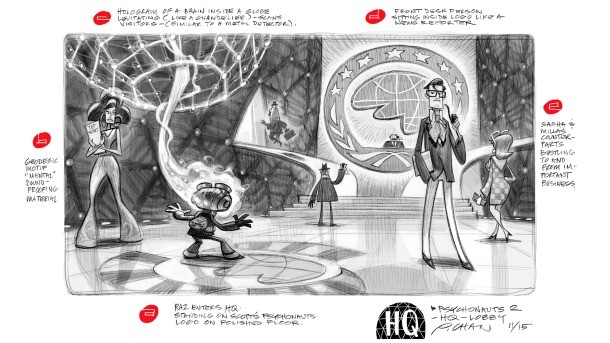
Psychonauts’ passionate fanbase has demanded a sequel for years; a request Double Fine repeatedly tried to grant. Following the first game’s release, the team had a ton of story ideas and concepts for the sequel and spent the better part of the last decade sporadically pitching the game to publishers. However, the series’ trademark weirdness seemed to push publishers away, an outcome the team grew to foresee whenever the game was described as being “very creative” in pitch meetings. “That's their way of saying, ‘It's very terrifying and it's very scary to us,'" Schafer says.
While Double Fine struggled to get the sequel off the ground, the original Psychonauts gained increased popularity over the years through word of mouth, as well as renewed sales thanks to re-releases on digital storefronts such as Steam and PlayStation Network. In fact, Schafer says Psychonauts has sold twice as many copies in the last five years as it did in its first five years. This new awareness helped form the catalyst for a serious push for Psychonauts 2.
The final shove came from an unlikely source in Minecraft creator Markus “Notch” Persson. Back in February 2012, Persson tweeted Schafer proposing to fund a Psychonauts 2. The conversation sparked a wildfire of excited speculation – one that was doused a year later when Persson departed the project due to the game’s projected high development cost. While that came as a big disappointment to fans, that event wound up giving Schafer the drive he needed to pursue Psychonauts 2 head on.
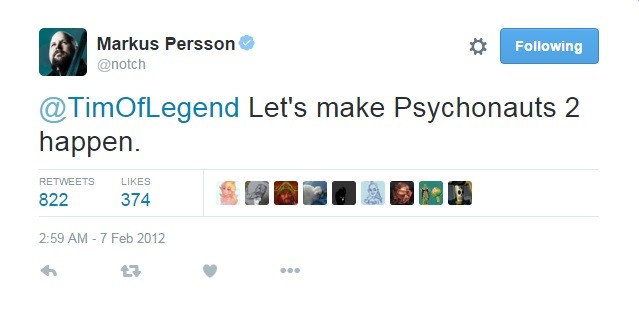
“You know, I got to know [Notch] when that first Twitter storm happened, and I have to credit him a little bit with reawakening that part of my brain that wanted to make Psychonauts," Schafer says. "After the last publisher round I kind of thought ‘Ah, it's not gonna happen,’ and I talked about that in [an] article, and that's what he saw that made him say, 'Hey, you should really make it.' And so I thought that could work, and I got excited about it, and then it turns not into something that was gonna work out. But I could not put that part of my brain to sleep anymore, and it was like, 'Well, you know what, now we just have to make this game by however we're gonna make', and luckily the new platform Fig came around which really, I think, makes it possible in a way that wasn't possible before. So we owe it to Notch for waking up the dormant desire to make Psychonauts in my head.”
When I asked about Notch becoming a potential Fig investor, Schafer simply stated “We are always in talks with Notch.”
Double Fine’s staff has grown in size in the last decade. Now, multiple teams exists and are able to knock out different titles, something Schafer says has helped him to focus entirely on developing the sequel because he won’t have to divide his attention leading other projects. As a whole, though, the studio looks forward to revisiting to the world of Psychonauts.
“It's a very emotional and, I think, meaningful game for a lot of the studio," Schafer says. "Especially for people that were here in the early days 15 years ago when we started working on that, but even some of the newer employees who came to the studio and couldn't be there for that first one are excited about being part of the second one. It's just great to have things like crowdfunding where you can actually make these crazy, creative things come back to life.”
Read on to learn about Psychonaut 2's Fig campaign, Schafer's crowdfunding reflections, and the possibility of a Psychonauts 2 development documentary .
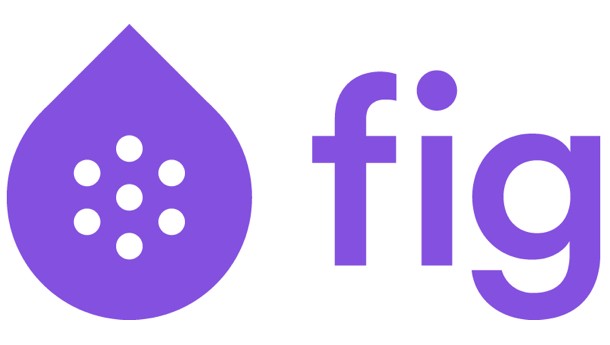
Double Fine is no stranger to crowdfunding, with Broken Age and Massive Chalice brought to life thanks to successful (if not tumultuous) Kickstarter campaigns. The switch to Fig isn’t surprising – Schafer sits on the company’s advisory board – but I was curious if the studio learned any lessons from making Broken Age in particular about reining in the scope of projects.
“It's really hard to compare," Schafer says. “Broken Age, I thought I was going to make this $300,000 Flash game, and then everything changed so much, and we didn't know what the game was at all or what the world was or who the characters were or anything when we started. But with [Psychonauts 2], we have this really known quality with quantity, which is Psychonauts 1. We made it before, we made this game, and now we want to do a new version...so I feel like, scope-wise, we have a model, and that helps us a lot because we're not asking for $400,000 and hoping to get $3.3 million. We're going to ask for the $3.3 million and hope to get $3.3 million because that, plus other funding sources, will allow us to make a game that matches the scope of the first game.”
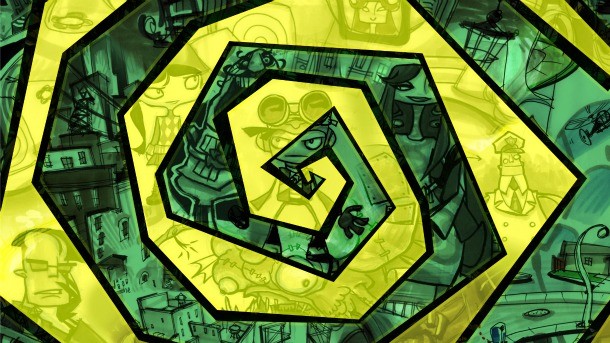
Crowdfunding also means Double Fine has to answer to backers – i.e., regular people – instead of a major publisher this time around. Schafer finds this shift in power dynamics more inviting because “taking feedback from someone who can't cancel your project is a lot friendlier than someone who is saying, 'Hey, make this change, insert this change so that we don't cancel you'.” This doesn’t mean Schafer won’t be taking backer suggestions seriously. He hopes to hear constant feedback from fans on things they’d like to see in Psychonauts 2, the elements they disliked about the first game, and ideas for overall improvement. “We'll be talking back and forth with the backers throughout the campaign and afterwards. We want to hear that feedback.”
Broken Age’s development campaign was chronicled in the acclaimed Double Fine Adventure documentary by 2 Player Productions. The studio is still filming Double Fine’s inner workings, and while there’s no official confirmation of how much of Psychonauts 2’s development will be captured or when such material would release, Schafer feels the presence of investors does require a similar transparency “because people are putting their trust in you, so you've got to show what you can.” Despite appearing worn out by the idea by the end of the Double Fine Adventure, Schafer recognizes the importance of letting gamers see the process behind bringing their favorite medium to life.
“So I think we'll still stay pretty transparent. It's just that we obviously couldn't be transparent about our secret plan to take over the world with Psychonauts.”
You can check out the Psychonauts 2 campaign on Fig's website.

Get the Game Informer Print Edition!
Explore your favorite games in premium print format, delivered to your door.
- 10 issues per year
- Only $4.80 per issue
- Full digital magazine archive access
- Since 1991









